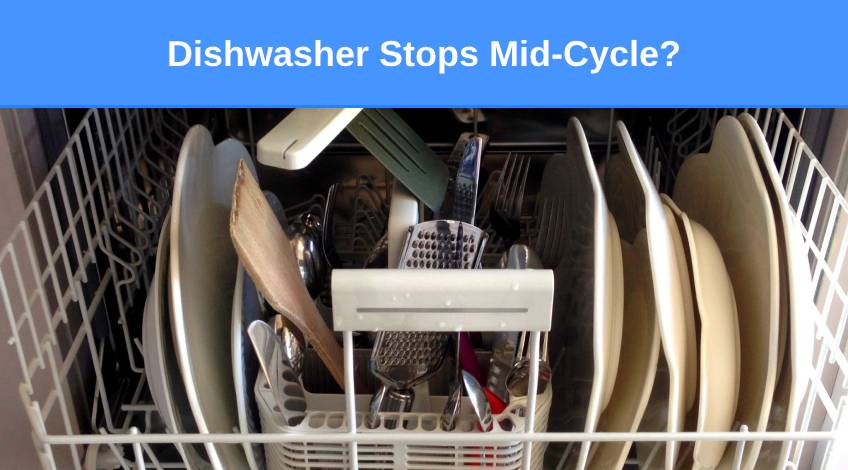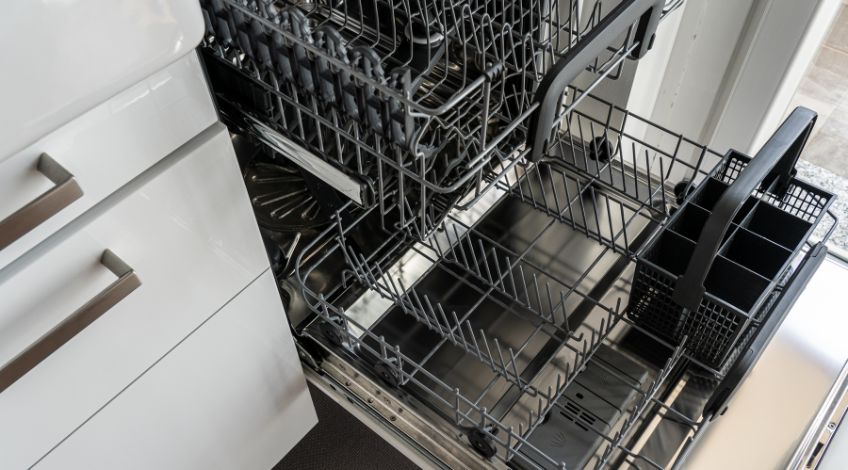
Dishwasher Stops Mid-Cycle? (here’s why & what to do)
If your dishwasher started its wash cycle and then suddenly stopped without any warning it can be worrying. In some cases the dishwasher won’t even start at all but the causes could be the same.
If your dishwasher has failed to start or started and stopped abruptly mid-cycle, keep reading. In this article we look at all of the possible reasons why a dishwasher might stop mid-cycle and offer solutions for these issues.
Why Has The Dishwasher Stopped Mid-Cycle?
There are several reasons why your dishwasher could have stopped mid-cycle leaving your dishes still greasy and covered in detergent residue. They include;
| Possible Cause | Solution |
|---|---|
| Power failure | Check the power supply |
| Blown fuse | Replace the fuse |
| Blown thermal fuse | Replace the thermal fuse |
| Defective door latch | Repair/replace the door latch or latch sensor |
| Clogged filter | Clean the filter |
| Blocked water inlet screen | Clean the water inlet screen |
| Low water pressure | Contact the water authority |
| Defective motor or pump | Contact a technician |
| Faulty fan | Contact a technician |
| Clogged spray arm | Clean the spray arm |
| Defective float switch | Contact a technician |
| Defective control board (PCB) | Contact a technician |
Power Failure

If the power to your home is cut for any reason, it will result in your dishwasher stopping mid-cycle. This could be the result of a power outage, bad weather event, or industrial action by power company staff.
Whatever has caused the power supply to be interrupted, it is enough to stop your dishwasher mid-cycle. If this is the reason why your dishwasher has stopped, once the power has been restored you can restart the cycle and get your dishes clean.
Blown Fuse
If there has been no disruption to your power supply, it’s worth checking the fuse in the dishwasher’s plug as well as the circuit breaker.
If the plug has blown or the circuit breaker has tripped, we recommend getting a technician or electrician to check the wiring for you before reusing the appliance.
Blown Thermal Fuse
Dishwashers have a safety device installed called the thermal fuse. It works by cutting the power to the appliance in the event that it overheats.
If the thermal fuse is blown, the appliance will not start until it is replaced. The thermal fuse is typically located close to the control board on most dishwashers but could also be inside the power board in some cases.
This is another task for an expert because you need to identify what caused the thermal fuse to blow. Otherwise the same thing will happen once the new one is fitted.
Defective Door Latch
The door latch prevents the door from opening whilst the dishwasher is in operation. The dishwasher will not start if the door latch is defective.
This is a safety feature to prevent your home from flooding if the door were to come open mid-cycle. Over time the door latch or door sensor can become damaged which could cause the dishwasher to stop mid-cycle.
You can visually check the door latch, while the sensor will need to be accessed and checked using a multimeter for continuity. If the latch or sensor prove to be defective, they will need to be replaced.
Clogged Filter

The filter on a dishwasher traps food particles and other debris preventing them from returning to the clean dishes. If the filter becomes clogged, it can prevent the dishwasher from draining waste water from the tub.
This will stop the appliance mid-cycle and you will need to clean the filter to restore your appliance to working order.
To clean the filter you will need to remove it from the dishwasher and wash it in warm soapy water to remove all trapped and rotting food particles and other debris. If the filter is particularly dirty you might need to scrub it using a toothbrush.
You can soak the filter in a bowl of white vinegar and water for 10 to 15 minutes to help remove any grease or fatty substances.
Blocked Water Inlet Screens
The dishwasher relies on the water inlet valve to supply it with all of the water it needs. The inlet valve is fitted with a screen or mini filter to prevent any grit etc that might be present in the water from blocking the valve.
The problem is that over time the inlet screen can become blocked with grit or even limescale if you live in a hard water area. If there is a blockage in the inlet screen, it can reduce the water flow into the appliance by so much that the appliance shuts down.
How To Clean The Water Inlet Screen
You will need to clean the screen to remove any blockage and to do this you will need to;
- Disconnect The Water Supply
Turn the water inlet tap to fully off. - Remove The Water Inlet Hose
Unscrew the water inlet hose from the dishwasher. - Locate The Screen
Inside the exposed end of the inlet valve you will see a plastic screen. This can be removed carefully using a pair of long nosed pliers. - Wash The Screen
Run the screen under running water to remove any debris you might find. Take care as the screen can be easily damaged. Any stubborn limescale should be soaked in white vinegar to remove. - Replace The Screen
Once you’re satisfied that the screen is clean and free from any blockages, you can gently replace it. Then replace the water inlet hose before restoring the water supply.
Low Water Pressure
Dishwashers need a water pressure of between 20 to 120 Psi (pounds per square inch) to function correctly. If the dishwasher isn’t receiving enough water due to low water pressure, it could cause it to stop mid-cycle.
You can check the water pressure entering your home by filling a 1 gallon (4.5 litre) bucket with water from the cold tap in your kitchen. If it takes 30 seconds or less to fill, the water pressure entering your home is OK for running a dishwasher.
If it takes longer than 30 seconds, you will need to contact your local water authority.
Defective Motor/Pump
Another reason for the water pressure to be too low is if the pump or motor are malfunctioning. The dishwasher would be likely to shut down mid-cycle in the event of a faulty pump or faulty motor.
We recommend getting a technician to deal with this issue.
Faulty Fan

All dishwashers rely on a fan to pass hot air onto the dishes to get them dry and to remove steam and moisture during the drying cycle. If the fan develops a fault, moist air builds up in the appliance and the appliance eventually stops working.
If the fan has developed a fault, we recommend getting a technician to investigate and repair/replace the fan for you.
Clogged Spray Arm
Water is spread around the dishwasher via the two spray arms, if these become blocked and there’s insufficient water to clean the dishes, the appliance could stop mid-cycle.
To solve this, you will need to remove the spray arm and soak it in warm soapy water. Then inspect the nozzles for any remaining blockages.
These could be limescale deposits which can be further soaked in white vinegar. Any remaining clogs can be gently removed using a toothpick but make sure you prise the blockage out and don’t force it further into the nozzle.
Defective Float Switch
The float switch controls the water level in the dishwasher. Once a predetermined level has been achieved, the float switch activates causing the water to stop flowing.
If the float switch becomes faulty the appliance will cut out mid-cycle to prevent flooding.
We recommend getting a technician to solve this issue.
Defective Control Board
The control board (or Printed Circuit Board, or PCB for short) controls every function on the dishwasher. If it develops a fault, it could stop the appliance mid-cycle.
Unfortunately, there are many issues that could cause a similar problem which means it can be difficult to pin it down to the PCB. However a technician will be able to recognise any faulty components.
Which is why we recommend getting expert help in diagnosing and fixing this fault.
SEE ALSO: Bosch Dishwasher Starts Then Stops? (here’s why & how to fix)
Frequently Asked Questions
If your dishwasher shuts off mid-cycle it’s probably because; there’s a power failure, the fuse is blown, the thermal fuse has blown, the door latch or sensor is defective, the filter is blocked, the water inlet screen is blocked, there’s low water pressure, the motor or pump is defective, the fan is faulty, the spray arm is clogged, the float switch is faulty or the PCB is defective.
Yes, it is normal for the dishwasher to start and stop a few times during the cycle. This is to allow the waste water to drain out of the appliance before fresh, clean water is added to rinse the dishes.
If your dishwasher runs for 20 minutes and then shuts off it’s most probably because the heat pump is defective. You will need to get the heat pump replaced to resolve this issue.
If your dishwasher shuts off after 30 seconds it’s most likely to be a defective water inlet valve. If the dishwasher doesn’t fill with water, it will shut off and not advance to the next stage of the cycle.
Also, follow us on Pinterest ...



